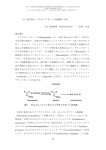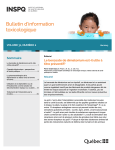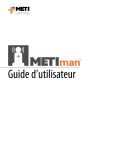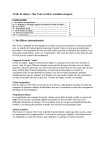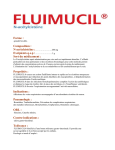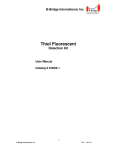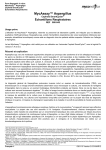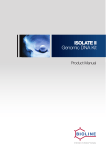Download Acétylcystéine Injectable
Transcript
ACETYLCYSTEINE INJECTION 200 MG/ML (20%) THERAPEUTIC CATEGORY: MUCOLYTIC / ANTIDOTE FOR ACETAMINOPHEN POISONING ACTION: The viscosity of respiratory mucous secretions depends primarily on the content of mucoprotein and to a smaller extent on the concentration of desoxyribonucleric acid (DNA). The proportion of DNA is increased with the presence of purulent material, due to cellular debris. The mucolytic action of acetylcysteine is related to the sulphydryl group in the molecule. This group probably “opens” disulphide bonds in mucus, thereby lowering the viscosity. The mucolytic activity of acetylsteine is unaltered by the presence of DNA, and increases with increasing pH, with significant mucolysis occurring between pH 7 and 9. Acetaminophen overdosage causes damage due to excessive formation of a highly reactive alkylating metabolite which binds irreversibly to protein molecules within the hepatocyte. After therapeutic doses, acetaminophen is excreted principally as the glucuronide and sulfate conjugates and only approximately 8% of the acetaminophen ingested is transformed into the toxic metabolite. Hepatic-reduced glutathione rapidly activates this metabolite, which is excreted by the kidneys as non-toxic cysteine and mercapturic derivatives. However, after an overdose of acetaminophen (150 mg/kg or greater) the glucuronide and sulfate conjugation pathways are saturated and a larger fraction of the parent drug is metabolized to form the alkylating metabolite. Hepatic-reduced glutathiones stores are depleted and the excess metabolite causes hepatic damage and necrosis. Acetylcysteine probably protects the liver by maintaining or restoring the glutathione levels or by acting as an alternative substrate for conjugation with the reactive metabolite. INDICATIONS: As a mucolytic agent: Acetylcysteine is indicated as adjuvant therapy for patients with abnormal, viscid or inspissated mucous secretions in such conditions as; chronic bronchopulmonary disease such as emphysema, chronic bronchitis, lung abscess, tuberculosis, bronchiectasis, and primary amyioidosis of the lung; acute bronchopulmonary disease such as pneumonia, bronchitis and tracheobronchitis; pulmonary complications of cystic fibrosis; tracheostomy care, pulmonary complications associated with surgery; use during anesthesia; post-traumatic chest conditions and pulmonary collapse; diagnostic bronchial studies such as bronchograms, bronchospirometry and bronchial wedge catheterization. Use the pathology laboratory: Acetylcysteine is used for the digestion of sputum in examinations for M. Tuberculosis and for carcinoma cells. As an antidote for acetaminophen poisoning: Acetylcysteine is indicated as an antidote to prevent or lessen hepatic injury which may occur following the ingestion of a potentially hepatotoxic quantity of acetaminophen. CONTRAINDICATIONS: Acetylcysteine is contra-indicated in those patients who are sensitive or who have developed sensitivity to it. There are no known contraindications to oral administration of acetylcysteine in the treatment of acetaminophen overdose. WARNINGS: After proper administration of acetylcysteine an increased volume of liquefied bronchial secretions may occur. When cough is inadequate the airway should be cleared by endotracheal aspiration with or without bronchoscopy. Asthmatics under treatment with acetylcysteine should be watched carefully. If bronchospasm progresses, this medication should be immediately discontinued. Generalized urticaria has been observed rarely in patients receiving oral acetylcysteine for acetaminophen overdose. If this and other allergic symptoms occur, treatment with acetylcysteine should be discontinued unless it is deemed essential this and the allergic symptoms can otherwise be controlled. Although there are no data indicating that acetylcysteine adversely influences hepatic failure, this remained a theoretical possibility. Therefore, in the presence of hepatic failure due to acetaminophen overdose the degree of existing liver damage and the possible risk associated with the administration of acetylcysteine should be considered. PRECAUTIONS: After administration of acetylcysteine a slight disagreeable odor may be noticed initially. When a face mask is used, after nebulization, a stickiness on the face may be noticed; this is easily removed by washing with water. Under certain conditions, acetylcysteine may change its colour to a light purple in the open vial. This colour change is due to a chemical reaction which does not significantly impair the mucolytic activity or the safety of the drug. After prolonged nebulization, extreme concentration of acetylcysteine in the solvent may occur. This might impede nebulization and efficient delivery of the drug. If this occurs, Sterile Water for Injection USP should be used to dilute the nebulizing solution. Occasionally severe and persistent vomiting occurs as a symptom of acute acetaminophen overdose. The administration of acetylcysteine may aggravate the vomiting. Patients at risk of gastric hemorrhage (e.g. esophageal varices, peptic ulcers, etc.) should be evaluated concerning the risk of upper gastrointestinal hemorrhage versus the risk of developing hepatic toxicity and treatment with acetylcysteine given accordingly. The propensity of oral acetylcysteine to aggravate vomiting is minimized when it is administered diluted in cola drinks. Acetylcysteine should be used with caution in asthma or where there is a history of bronchospasm. Acetylcysteine may cause a false-positive reaction with reagent dipstick tests for urinary ketones. Acetylcysteine is not compatible with rubber and metals, particularly iron, copper and nickel. Silicone rubber and plastic are satisfactory for use with acetylcysteine. SIDE EFFECTS: Adverse effects include stomatitis, nausea and rhinorrhea. Sensitivity and sensitization to acetylcysteine have been reported very rarely. Asthmatics and other susceptible patients may experience varying degrees of bronchospasm associated with the administration of nebulized acetylcysteine. In most cases, this is quickly relieved by the use of a bronchodilator given by nebulization. Rash, asthma and anaphylactoid reactions have been reported with I.V use. These occur most commonly either during or at the end of the period an initial high-dose infusion, and may in fact be dose-related. If the anaphylactoid manifestations are mild, and the patient is at high risk of liver toxicity, consideration should be given to continuing the acetylcysteine infusion at a reduced rate. However, this should be given only after discussion with a physician with substantial experience in the treatment of acetaminophen poisoning for a full consideration of possible risks and benefits and with appropriate supportive equipment available. Oral administration of the large doses needed to treat acetaminophen overdose may result in nausea, vomiting and other gastrointestinal disorders. Rash, with or without mild fever has been reported rarely. Hypokalemia and ECG changes have been noted in patients with acetaminophen poisoning irrespective of treatment given. Monitoring of plasma potassium is therefore recommended. DOSAGE AND ADMINISTRATION AS A MUCOLYTIC AGENT: Acetylcysteine is a 20% solution which may be diluted to a lesser concentration with either sterile normal saline or sterile distilled water. Nebulization- face mask, mouthpiece, tracheostomy: When nebulized into a face mask, mouthpiece or tracheostomy, 1 – 10 mL of the 20% solution may be given every 2 – 6 hours: the recommended dose for most patients is 3 – 5 mL of the 20% solution three to four times a day. Nebulization- tent, croupette: In special circumstances it may be necessary to nebulize into a tent or croupette, and this method must be individualized to take into account the available equipment and the patient’s particular needs. This from of administration requires very large volumes of the solution occasionally as much as 300 mL during a single treatment period. If a tent or croupette must be used, the recommended dose is the volume of 20% solution which will maintain a very heavy mist in the tent or croupette for the desired period. Administration for intermittent or continuous prolonged periods, including overnight, may be desirable. Direct instillation: When used by direct instillation, 1.5 mL of a 10 – 20% solution may be given as often as every hour. When used for the routine nursing care of patients with tracheostomy, 1 – 2 mL of a 10 – 20% solution may be given every 1 – 4 hours by instillation into the tracheostomy. Acetylcysteine may be introduced directly in to a particular segment of the bronchopulmonary tree by inserting (under local anesthesia and direct vision), a small plastic catheter into the trachea. Acetylcysteine may also be given through a percutaneous intratracheal catheter. Diasgnostic bronchograms: For diagnostic bronchial studies, 2 or 3 administrations of 1 – 2 mL of the 20% solution should be given by nebulization or by instillation intratracheally, prior to the procedure. ADMINISTRATION AEROSOL: Acetylcysteine is usually administered as a fine nebulae for its local effect and the nebulizer used should be capable of providing optimal quantities of a suitable range of particle sizes. Certain materials used in nebulization equipment react with acetylcysteine. The most reactive are metals (particularly iron and copper) and rubber. Where materials may come into contact with acetylcysteine solutions, parts made of glass or plastic should be used. The nebulized solution may be breathed directly from the nebulizer. Nebulizers may also be attached to plastic face masks, plastic face tents, plastic mouthpieces, conventional plastic oxygen tents or head tents. Suitable nebulizers may also be fitted for use with the various intermittent positive pressure breathing (IPPB) machines. The nebulizing equipment should be cleaned immediately after use, the residues may occlude the fine orifices or corrode metal parts. Prolonged nebulization: When ¾ of the initial volume of acetylcysteine solution has been nebulized a quantity of Sterile Water for Injection USP (approximately equal to the volume of solution remaining) should be added to the nebulizer. This obviates any concentration of the agent in the residual solvent remaining after prolonged nebulization. STORAGE OF OPEN VIALS: If only a portion of the solution in the vial is used to minimize contamination the remainder should be stored in a refrigerator and used within 96 hours. COMPATIBILITY: Acetylcysteine may be mixed with the topical anesthetics lidocaine hydrochloride (4%) and amethocaine hydrochloride (2%), the X-ray contrast media propyliodone and the bronchodilator isoprenaline. It is incompatible with iodized oil (Lipiodol). Antibiotics which may be mixed with acetylcysteine include polymixin B sulphate, streptomycin sulphate, methicillin sodium, novobiocin sodium and dihydrostreptomycin sulphate. If it is deemed advisable to prepare an admixture it should be administered immediately after preparation. Do not store mixtures. Antibiotics found to be incompatible when mixed in solution with acetylcysteine include tetracycline hydrochloride, oxytetracycline hydrochloride, erythromycin lactobionate and oleandomycin. These agents may be aministered by nebulization from separate solutions if necessary. DOSAGE AND ADMINISTRATION AS AN ANTIDOTE FOR ACETAMINOPHEN POISONING: Acetylcysteine should be administered immediately if 24 hours or less have elapsed from the reported time of ingestion of an overdose of acetaminophen, regardless of the quantity reported to have been ingested. NOTE: The criticavl ingestion – treatment interval for complete protection against severe liver damages is 8 hours. Efficacy diminishes progressively thereafter and treatment beteween 15 and 24 hours post-ingestion of acetaminophen is usually ineffective. However, it does not appear to worsen the condition of patients and it should not be withheld, since the reported time of ingestion may not be correct. It should be kept in mind that after a fatal dose of acetaminophen, the patient may appear relatively well initially and may even continue normal activities for a day or two before the onset of hepatic failure. GENERAL MANAGEMENT: in the case of patients admitted within 4 hours of ingestion, the stomach should be emptied promptly by lavage or by inducing emesis with syrup of ipecac. Syrup of ipecac should be given in a dose of 15 to 30 mL for children and 30 to 45 mL for adults, accompanied by drinking copious quantity of water. The dose should be repeated if emesis does not occur within 20 minutes. In the case of mixed drug overdose, activated charcoal may be indicated. However, since activated charcoal will absorb acetylcysteine and reduce its effectiveness, gastric aspiration and lavage should be performed before administering acetylcysteine orally. On admission, blood should be drawn for determination of acetaminophen plasma levels, which will serve as a basis for determining the need for continuation of treatment with acetylcysteine, SGOT, SGPT, bilirubin, prothrombin time, creatinine, BUN, blood sugar and electrolytes also should be determined in order to monitor hepatic and renal function and electrolyte and fluid balance. I.V Treatment with Acetylcysteine: Single use vials when used I.V. Discard unused portion. Acetylcysteine should be given intraveneously in an initial dose of 150 mg/kg in 5% dextrose (see Table 1 for volume) over 15 minutes, followed by 50 mg/kg in 500 mL of 5% dextrose over 4 hours and 100 mg/kg in one litre of 5% dextrose over the next 16 hours (total dose: 300 mg/kg in 20 hours) (See Dosage Guide. Table 1). The treatment with Acetylcysteine may also be continued if the acetaminophen assay reveals non-toxic plasma levels. hepatoxicity. Chronic alcohol ingestion and/or concomitant barbiturate therapy may induce a greater formation of the toxic metabolite for any given dose of acetaminophen. This should be kept in mind when therapy is based upon blood levels of acetaminophen. The following plasma levels of acetaminophen, related to hours post-ingestion, are associated with hepatic toxicity. TABLE 2: PLASMA LEVELS µg/mL HOURS POST-INGESTION 150 4 70 8 20 15 4 24 Infusion of Acetylcysteine should be continued in patients with these or higher concentrations of acetaminophen in plasma. Acetylcysteine treatment should be initiated immediately regardless of whether or not plasma levels are available on admittance. Acetylcysteine treatment may be discontinued if plasma levels of acetaminophen are below those given in Table 2. The possibility of chronic alcohol ingestion and/or concomitant barbiturate therapy should be considered when evaluating the possibility of discontinuing treatment, since in these instances blood levels of the parent drug may undersestimate the true risk of hepatotoxicity. ORAL TREATMENT WITH ACETYLCYSTEINE Administer the loading dose of acetylcysteine, 140 mg/kg of body weight (Prepare Acetylcysteine for oral administration as described in Table 3). Four hours after the loading dose administer the first maintenance dose (70 mg/kg/body weight) of acetylcysteine. The maintenance dose is then repeated at 4 hour intervals for a total of 17 doses unless the acetaminophen assays reveal a non-toxic level as discussed below. If the patient vomits the loading dose or any one of the maintenance doses within one hour of administration, repeat that dose. If the patient is unable to retain the orally administered acetylcysteine, the antidote may be administered by duodenal intubation. Liver function tests should be repeated daily if acetaminophen levels are within the potentially toxic range as discussed in below. PREPARATION OF ACETYLCYSTEINE SOLUTION FOR ORAL ADMINISTRATION The original 20% solution should be diluted to a 5% solution with cola drinks. Each diluted solution should be consumed within an hour of preparation. Remaining undiluted solutions in open vials may be stored under refrigeration for up to 96 hours. If acetylcysteine is to be administered by gastric tube, water may be used as a diluent. The relative amounts of the 20% solution of acetylcysteine and of diluent to be mixed according to body weight of the patient are indicated in Table 3. TABLE 3: DOSAGE GUIDE AND PREPARATION, DOSE OF ACETYLCYSTEINE Body Weight (kg) Grams mL of Diluent Total mL of 5% Solution 100 – 110 15 90 – 100 14 75 225 300 70 210 80 – 90 280 13 65 195 260 70 – 80 11 55 165 220 60 – 70 10 50 150 200 50 – 60 8 40 120 160 40 – 50 7 35 105 140 30 – 40 6 30 90 120 20 – 30 4 20 60 80 mL of 20% LOADING DOSE MAINTENANCE DOSE 100 – 110 7.5 37 113 150 90 – 100 7 35 105 140 80 – 90 6.5 33 97 130 70 – 80 5.5 28 82 110 60 – 70 5 25 75 100 50 – 60 4 29 60 80 40 – 50 3.5 18 52 70 30 – 40 3 15 45 60 20 – 30 2 10 30 40 ** If patients weighs less than 20 kg, usually patients younger than 6 years, calculate the doses of Acetylcysteine. Each mL of 20% contains 200 mg of acetylcysteine. The loading dose is 140 mg/kg/body weight. The maintenance dose is 70 mg/kg. Three mL of diluent are added to each mL of 20% Acetylcysteine. Do not decrease the proportion of diluent. Increased gastrointestinal irritation is often asociated with increased concenrations of Acetylcysteine. SUPPORTIVE TREATMENT OF ACETAMINOPHEN OVERDOSE: 1. Maintain fluid and electrolyte balance based on clinical evaluation of state of hydration and serum electrolytes. 2. Treat as necessary for hypoglycemia. 3. Administer Vitamin K1 if prothrombin time ratio exceeds 1.5 or with fresh frozen plasma if the prothrombin time ratio exceeds 3.0. 4. Diuretics and forced dieresis should be avoided. Hemodialysis or peritoneal dialysis has not been found helpful. ACETAMINOPHEN ASSAYS Hepatic toxicity may result from the acute ingestion of 150 mg/kg or more acetaminophen. The reported quantity of a drug ingested after an overdose is often inaccurate and is not a reliable guide to therapy of the overdose. THEREFORE, PLASMA OR SERUMACETEMINOPHEN CONCENTRATIONS, DETERMINED AS EARLY AS POSSIBLE. BUT NO SOONER THAN FOUR HOURS FOLLOWING INGESTION OF AN ACUTE OVERDOSE, ARE ESSENTIAL IN ASSESSING THE POTENTIAL RISK OF HEPATOTOXICITY. DO NOT WAIT FOR ASSAY RESULTS TO BEGIN ACETYLCYSTEINE TREATMENT. For any given dose of acetaminophen, a greater formation of toxic metabolite may occur if there is a history of chronic alcohol ingestion and/or concomitant barbiturate of acetaminophen assays. (Refer to nomogram, Figure 1). 1. Acetaminophen plasma concentrations above the solid line which connects 200 ug/mL at 4 hours with 50 ug/mL at 12 hours re associated with a possibility of hepatic toxicity if an antidote is not administered. 2. Plasma levels above the broken line may be associated with hepatic toxicity is minimal and acetylcysteine is indicated. 3. If plasma levels of acetaminophen are below the broken line the risk of hepatic toxicity is minimal and acetaminophen and not conjugated. HPLC: 1. Blair. D.. and Rumack, B.H.: Clin. Chem. 23(4): 743-745 (April) 1977. 2. Howie, D.. Andriaensesens, P.I.. and Prescott, L.F.: Journ. Pharm. And Pharmacol. 29 (4) 235-237 (April) 1977. GLC 3. Prescott. L.F.. Journ. Pharm and Pharmacol. 23 (10) 804-808 (Oct.) 1971. Colourimetric. 4. Glynn, J.P. and Kendal, S.E.: The Lancet. 1:1147-1148. (17 May)1975. AVAILABILITY: Each mL of sterile solution contains acetylcysteine 200 mg, disodium edetate 0.5 mg/mL and sodium hydroxide to adjust pH. Preservative free, lacquered rubber sloppered glass vials of 10 mL and 30 mL, in trays of 10. STORAGE: Store at room temperature (15 – 30°C) if unopened. Single use vials when used I.V. Discard unused portion If previously opened, do not use I.V. When used, for inhalation or oral administration, unused portions should be stored in a refrigerator and used within 96 hours. PHARMACOLOGY: Acetylcysteine is the N-acetyl derivative of the naturally occurring amino acid L-cysteine powder which melts at 104 –110°C and has a very slight odor. It has a molecular weight of 163.2. Acetylcysteine administered orally to pre-fasted CF-1 mice, 1 hour after an overdose of acetaminophen (1500 mg/kg p.o.). produced the following 7 day survival rates: 0 mg/kg, 4/15: 300 mg/kg, 9/15; 600 mg/kg, 14/15; and 1200 mg/kg, 15/15. In a separate study, 1200 mg/kg of acetylcysteine was administered orally to CF-1 mice 1 hour after an overdose (1200 mg/kg) of acetaminophen. The media SGPT in untreated mice rose to 4026 I.U./L whereas in acetylcysteine treated mice SGPT only reached 47 I.U./L. Acetylcysteine was compared with cysteamine (oral doses of 1200 mg/kg and 200 mg/kg, respectively) at different times after acetaminophen overdosage (1200 mg/kg). Acetylcysteine was more efficacious than cysteamine in both overall survival rate and effectiveness on late administration. When acetylcysteine was administered 4 ½ hours after the acetaminophen overdose, 12/15 mice survived, whereas in the cysteamine treated group only 1/15 mice survived. This protection by acetylcysteine is noteworthy since unprotected mice become debilitated by 1 ½ hours, have raised SGPT after 3 ½ hours and die as early and 4 – 5 hours after acetaminophen overdosage. When acetylcysteine was administered at the time which coincided with maximal liver insult, a slight protection was noted. Methionine showed a similar pattern of action, whereas cysteamine appeared to worsen the overall condition of the animals. Acetylcysteine administered intravenously produced the same protective effect as when given orally. TOXICOLOGY: A single dose of 6 g p.o. induced only transient hypoactivity in mice. Acetylcysteine has been administered intravenously to patients on gold therapy at a dose of approximately 120 mg/kg/day (6 g over 24 hours) with no apparent adverse effects. Estimating Potential for Hepatotoxicity: A nomogram, Figure 1 has been developed to estimate the probability that plasma levels in relation to intervals post-ingestion will result in hepatotoxicity. TABLE 1: DOSAGE GUIDE ACCORDING TO BODY WEIGHT INITIAL INFUSION (in 5% dextrose over 15 minutes) 2ND INFUSION (in 500 mL 5% dextrose over 4 hours) 3RD INFUSION (in 1 litre 5% dextrose over 16 hours) Acetylcysteine (mL) Body Weight (kg) Acetylcysteine (mL) 5% Dextrose (mL) Acetylcysteine (mL) 10 – 15 11.25 40 3.75 7.5 15 – 20 15.00 50 5.00 10.00 20 – 25 18.75 75 6.25 12.50 25 – 30 22.50 75 7.50 15.00 30 – 40 30.00 100 10.00 20.00 40 – 50 37.50 200 12.50 25.00 50 – 60 45.00 200 15.00 30.00 60 – 70 52.50 200 17.50 35.00 70 – 80 60.00 200 20.00 40.00 80 – 90 67.50 200 22.50 45.00 90 – 100 75.00 200 25.00 50.00 100 – 110 82.50 200 27.50 55.00 The volumes and rates of infusion for children suggested above must be adjusted according to the medical circumstances and restrictions in the volume of parenteral fluids administered, as they apply to each individual patient. ACETAMINOPHEN ASSAYS: Interpretation and Methodology: An overdose of acetaminophen of 150 mg/kg or greater may result in liver damage. However, no reliance can be placed on the number of tablets claimed to have been taken by the patient and early specific clinical manifestations of acetaminophen poisoning. As well, maximal biochemical abnormalities of liver function are usually manifested only 3 – 5 days after ingestion. Therefore, plasma or serum acetaminophen concentrations determined as early as possible, but no sooner than four hours following an acute overdose, are essential in assessing the potential risk of CLIENT PROJECT NO. ISSUED CODE REF FILE NAME Date of Revision: March 2014 Alveda Pharmaceuticals Inc. Toronto, ON, M4T 1L9 1-800-656-0793 www.alvedapharma.com ALVEDA PHARMA 1419-14 21/03/14 ALV_ACETYLSYSTEINE_INSERT COLOURS BLK TRIM 210 X 594 MM BLEED DIELINE ARTIST MD ACETLCYSTEINE MODIFIED 02/05/14 v1.5 APPROVED & PROCEED SIGNATURE AMEND & RESUBMIT DATE ACÉTYLCYSTÉINE INJECTION 200 MG/ML (20%) CATÉGORIE THÉRAPEUTIQUE : MUCOLYTIQUE/ ANTIDOTE DANS L’INTOXICATION À L’ACÉTAMINOPHÈNE PHARMACOLOGIE : La viscosité de sécrétions des voies respiratoires dépend principalement de leur teneur en mucoprotéines et, d’une façon moindre, de leur concentration en acide désoxybonucléique (ADN). La proportion de ADN augmente en présence de substance purulentes à cause des débris cellulaires. L’action mucolytique de l’acétylcystéine est associée au groupe sulphydryl de la molécule. Ce groupe « pénètre » des liens disulphides dans le mucus abaissent ainsi la viscosité. L’activité mucolytique de l’acétylcystéine n’est pas modifiée en présence de ADN et elle augmente avec la hausse du pH, une mucolyse d’ordre significatif se produisant entre pH 7 et 9. Le surdosage d’acétaminophène cause des lésions du foie par suite de la formation d’un métabolite alcoylant hautement réactif qui se lie de façon irréversible aux molécules protéiniques à l’intérieur de l’hépatocyte. Les doses thérapeutiques d’acétaminophènes sont excrétées principalement sous forme de glocurono et de sulfoconjugués et seulement environ 8% de l’acétaminophène ingéré est transformé en métabolite toxique. Le glutathion réduit dans le foie détruit rapidement l’activité de ce métabolite qui est excrété par les reins sous forme de cystéine non toxique et de dérivés mercapturiques. Cependant, suite à un surdosage d’acétaminophène (dose de 150 mg/kg ou davantage), les voies de synthèse des glucuronoet des sulfoconjugués sont saturés et une fraction plus importante de la substance mère est métabolisée pour former le métabolite alcoylant. Les réserves hépatiques de glutathion réduites sont épuisées et l’excédent de métabolite cause de la nécrose hépatique. L’acétylcystéine protège probablement le foie en maintenant ou en restaurant les taux de glutation ou en agissant comme substrat de rechange dans la conjugation avec le métabolite réactif. INDICATIONS : Agent mucolytique : acétylcystéine est indiqué en thérapeutique adjuvante en présence de sécrétions visqueuses et épaisses chez les sujets porteurs d’affection bronchopulmonaire chronique telle qu’emphysème, bronchite chronique, abcès pulmonaires, tuberculose, bronchiectasie et amylose pulmonaire primaire; maladies bronchopulmonaires aigues telles que pneumonie, bronchite et trachéobronchite; complications pulmonaires de la fibrose kystique, soin des trachéotomies, complications pulomnaires de la chirurgie; au cours d’une anasthésie; affectation thoraciques, post-traumatiques et affaisement du poumon; examens bronchiques, diagnostiques tels que bronchogramme, bronchospiromètre et cathétérisme bronchiale. Au laboratoire d’anatomie-pathologie : acétylcystéine est utilisé pour favoriser la digestion des sécrétions pour examens diagnostiques de M. Tuberculosis ou de cellules cancéreuses. Antidote dans un cas de surdosage à l’acétaminophène : acétylcystéine est indiqué comme une antidote pour prévenir, ou amoindrir la lésion hépatique susceptibles de se produire suite à une ingestion d’une quantité d’acétaminophènes qui pourrait s’avérer hépatotoxique. cancéreuses. CONTRE-INDICATIONS : acétylcystéine est contre-indiqué chez les sujets qui y sont sensibles ou qui y sont devenus sensibles. Il n’existe pas de contre-indications à l’administration orale d’acétylcystéine dans le traitement de l’intoxication par l’acétaminophène. MISE EN GARDE : Suite à l’administration d’acétylcystéine selon le mode d’emploi donné, une augmentation de volume des sécrétions bronchiques liquéfiées peut se produire. Lorsque la toux est inefficace, on doit assurer la béance des voies aériennes par succion mécanique au besoin. En présence de bloquage méchanique important dû à un corps étranger ou à une accumulation locale, on doit assurer l’ouverture des voies aériennes par aspiration endotrachéale avec ou sans bronchoscopie. Les asthmatiques traités par acétylcystéine doivent être surveillés de prêt. Discontinuer immédiatement l’administration de l’acétylcystéine si le bronchospasme progresse. On a rarement observé de l’urticaire généralisé chez les sujets traités par l’acétylcystéine orale pour surdosage d’acétaminophène. Si ces symptômes allergiques ou d’autres de même nature se manifestent, interrompre le traitement à moins qu’il ne soit considéré absolument essentiel et que les symptômes d’allergie ne puissent être enrayés. Bien qu’il n’existe pas de preuves que l’acétylcystéine n’ait jamais eu une influence néfaste sur l’insuffisance hépatique, ce fait demeure théoriquement possible. En conséquence, en présence d’insuffisance hépatique associée au surdosage d’acétaminophène, on doit considérer l’étendue de la lésion hépatique et le risque possible de l’administration de acétylcystéine. PRÉCAUTIONS : Une odeur désagréable peut se dégager suite à l’administration de acétylcystéine. La nébulisation par masque facial peut laisser la figure légèrement poisseuse; le cas échéant, laver à l’eau claire. Dans certaines circonstances, l’acétylcystéine peut prendre une coloration violette dans le flacon débouché. Elle est due à une réaction chimique qui ne diminue pas sensiblement l’activité mucolytique ou la sécurité du médicament. Suite à une nébulisation prolongée, la concentration de l’acétylcystéine dans le diluant peut être excessive. Le cas échéant, le processus de la nébulisation peut être gêné et entraînant l’inefficacité de la délivrance du médicament. Diluer alors la solution avec de l’eau stérile pour injection USP. Des vomissements sévères et persistants sont parfois le symptôme d’un surdosage aigu à l’acétaminophène. L’administration d’acétylcystéine peut aggraver les vomissements. Aussi, dans le cas, il existe un risque d’hémorragie gastrique (par exemple, en présence de varices eusophagiennes, d’ulcère gastro-duodénale) on doit peser le risque d’hémorragie gastro-intestinale par rapport à celui de toxicité hépatique avant d’administrer l’acétylcystéine. Pour atténuer le risque d’aggravation des vomissements, diluer l’acétylcystéine dans une boisson au cola. L’acétylcystéine doit être utilisée avec prudence dans le cas d’asthme ou d’histoire de bronchospasmes. L’acétylcystéine pourrait causer une fausse réaction positive avec les réactifs des tests de bandelettes réactivent pour les cétones urinaires. L’acétylcystéine est incompatible avec le caoutchouc et les métaux, particulièrement le fer, le cuivre et le nickel. On peut utiliser du silicone de caoutchouc et du plastique. EFFETS SECONDAIRES : Les effets indésirables les plus fréquents sont la stomatite, les nausées et la rhinorrhée. L’hypersensibilité et l’hypersensibilisation à l’acétylcystéine n’ont été que rarement rapportées. Les asthmatiques et autres sujets sensibles peuvent manifester à des degrés divers, un bronchospasme associé à l’administration d’acétylcystéine en nébuliseur. Dans la plupart des cas, le soulagement est obtenu par l’usage de bronchodilatateur en nébuliseur. Des éruptions transitoires de l’asthme et des réactions anaphylactoïdes ont été reportées avec l’usage par I. V. Celles-là surviennent le plus fréquemment durant, ou à la fin, de la période de l’infusion dose élevé initiale et pourraient en effet être reliées au dosage. Si le patient est à risque élevé de toxicité de foie, la continuation de l’infusion de acétylcytéine à un taux réduit doit être considérée. Cependant, cela doit être donné seulement après une discussion avec un médecin qui a une expérience substantielle dans le traitement de l’empoisonnement à l’acétaminophène pour une considération entière des risques et des bénéfices possibles et avec un équipement de support appropriée disponible. L’administration par voie orale de doses importantes nécessaires au traitement du surdosage d’acétaminophènes peut causer des nausées, des vomissements et autres effets gastro-inetinaux. Des éruptions accompagnées ou non d’une légère fièvre ont été rarement rapportées. De l’hipokalémie et des modifications de l’ECG ont été observées chez les sujets empoisonnés à l’acétaminophène indépendamment du traitement administré. On recommande donc de surveiller les taux de potassiums sérique. POSOLOGIE ET ADMINISTRATION À TITRE D’AGENT MUCOLYTIQUE : La solution à 20% peut être étendue avec un soluté de chlorure de sodium normal stérile ou de l’eau distillée stérile. Nébulisation – masque facial, sonde buccale, trachéotomie : par nébulisation dans un masque facial, une sonde ou une trachéotomie, administrer 1 à 10 mL de la solution à 20% aux deux à 6 heure; dans la plupart des cas, la dose est de 3 à 5 mL de la solution à 20%, 3 ou 4 fois par jour. Nébulisation – tente, croupette : Dans certaines circonstances spéciales, il peut être nécessaire de vaporiser le produit dans une tente ou une croupette. Le cas échéant, cette méthode doit être individualisée pour tenir compte de l’appareillage disponible et des besoins particuliers du patient. Cette méthode d’administration exige des volumes importants de solution, souvent, jusqu’à 300 mL au cours d’une seule période de traitement. Si l’usage de le tente ou de la croupette s’impose, la dose recommandée est le volume de solution à 20% qui assurera un brouillard très épais dans la tente ou dans la croupette durant la période nécessaire. L’administration intermittente ou continue pendant périodes prolongées, durant une nuit entière peut être souhaitable. Installation directe : en instillation directe la dose peut être de 1.5 mL de solution de 10 à 20% à toutes les heures. En thérapeutique, les infirmières habituées chez les trachéotomisés, la dose peut être de 1 à 2 mL de solution de 10 à 20%, tous les 1 à 4 heures par installation dans la trachéotomie. L’acétylcystéine peut être administrée directement dans un segment particulier de l’arbre bronchopulmonaire par insertion (sous anesthésie locale et vision direct) d’une petite sonde de plastique dans la trachée. On peut aussi servir d’un cathéther intratrachéal percutanée. Bronchogrammes diagnostiques : Pour l’examen brochial diagnostic, administrer 2 ou 3 doses à 1 à 2 mL de la solution à 20% par nébulisation ou par instillation intratrachéale avant le procédé. ADMINISTRATION DE L’AÉROSOL : L’acétylcystéine est ordinairement administrée sous forme de fin brouillard qui produit un effet local et le nébuliseur utilisé dost produire des quantitésoptimales d’une gamme convenable de diverses tailles de particules. Cerataines substances entrant dans la composition des nébulisateurs réagissent à l’acétylcystéine. Les plus réactifs sont les métaux (fer et cuivre surtout) et le caoutchouc. Il faut donc utiliser, pour les pièces venant en contact avec les solutions d’acétylcystéine, des appareils faits de verre ou de plastique. La solution peut être aspirée directement du nébuliseur. Celui-ci peut aussi être fixé à un masque facial en plastique, à une tente faciale en plastique, à des sondes buccales en plastique, à des tentes de modèles classiques en plastique ou à une tente de tête. Les nébuliseurs peuvent aussi être fixés aux divers appareils respiratoires à pression positive intermittente (IPPB). L’appareillage de nébulisation doit être nettoyé immédiatement après l’usage car les résidus risquent de causer l’obstruction des petits orifices ou la corrosion des parties de métal. Nébulisation prolongée : Lorsque les ¾ du volume initial de solution ont été nébulisés, on doit ajouter de l’eau stérile pour l’injection USP (un volume égal à celui de la solution restant dans le nébuliseur). On écarte ainsi la possibilité de la concentration de l’argent dans le dissolvant résiduel après une nébulisation prolongée. Entreposage des flacons entamés : Si l’on n’utilise qu’une portion de la solution, le flacon entamé doit être conservé au réfrigérateur et utilisé dans les 96 heures afin de minimiser le risque de contamination. Compatibilité : L’acétylcystéine peut être mélangée aux anasthégiques topiques suivants : chlorhydrate de lidocaine à 4% et la chlorhydrate d’amétocaine à 2%; on peut aussi la mêler au propyliodone, mileu de contraste en radiographie et à l’isoprénaline, agent bronchodilatateur. Elle est incompatible avec l’huile iodée (Lipiodol). Les antibiotiques qui peuvent être mélangées à l’acétylcystéine sont la sulfate de polymixine B, la sulfate de la streptomycine, la méthicilline sodique, la novobiocine sodique et la sulfate de dihydrostreptomycine. Il est préférable d’utiliser la mixture tout de suite après sa préparation. Ne pas entreposer les mélanges. Les antibiotiques qui sont incompatibles lorsque mélangés dans une solution comprenant l’acétylcystéine sont les suivants : la chlorhydrate de tétracycline, la chlorhydrate d’oxytétracycline, la lactobioante d’érythromycine et l’oléandomycine. Ces agents peuvent être utilisés en nébulisation mais séparément, au besoin. POSOLOGIE ET ADMINISTRATION À TITRE D’ANTIDOTE D’UN CAS DE SURDOSAGE À L’ACÉTAMINOPHÈNE : acétylcystéine doit être administré immédiatement dans les 24 heures ou moins se sont écoulées depuis le moment du surdosage à l’acétaminophène, quelle que soit la quantité ingérée. NOTE : L’intervalle critique ingestion-traitement pour protection totale contre les lésions hépatiques graves est de huit heures. L’efficacité de l’antidote diminue progressivement après cette période et 15 à 24 heures après l’ingestion d’acétaminophène, le traitement est inefficace. Cependant, il ne semble pas aggraver l’état du patient et on doit l’administrer quand même, le moment de l’ingestion pouvant avoir incorrectement noté. On ne doit pas perdre de vue qu’après l’ingestion d’une dose fatale d’acétaminophène, le sujet peut paraître relativement bien et continuer à vaquer à ses occupations normales pendant un jour ou deux avant que l’insuffisance hépatique ne survienne. PROCÉDÉ À SUIVRE : Chez les sujets admis dans les quatres heures qui suivent l’ingestion, procéder promptement à un lavage gastrique ou induire des vomissements par le sirop d’ipéca. Administrer une dose de 15 à 30 mL chez les enfants et de 30 à 45 mL chez les adultes et donner à boire de grandes quantités d’eau. En cas d’insuccès, répéter la dose d’émétique dans les 20 minutes qui suivent. En cas de surdosage d’un mélange de médicaments, il peut être indiqué de donner du charbon de bois activé. Étant donné que le charbon de bois activé absorbera l’acétylcystéine et diminuera son efficacité , on doit procéder à une aspiration et à un lavage gastrique avant d’administrer l’ acétylcystéine. À l’administration, on doit procéder des prélèvements de sang pour la détermination des taux sanguins d’acétaminophène. Ces données serviront à déterminer la nécessité de poursuivre le traitement par l’acétylcystéine. Procéder également aux dosages suivants : SGOT, SGPT, bilirubine, temps de prothrombine, créatinine, azote uréique sanguin, glycémie et électrolytes afin de contrôler les fonctions hépatiques et rénales ainsi que l’équilibre liquidien. I.V Traitment avec acétylcytéine : La fiole est unidose quand Acétylcytéine est administrée par voie I.V. Jeter tout produit inutilisé. Acétylcytéine doit être administrée par voie intraveineuse et la dose d’attaque est de 150 mg/kg dans dextrose à 5% (voir Tableau 1) durant 15 minutes, suivie de 50 mg/kg dans 500 mL de dextrose à 5% durant 4 h et de 100 mg/kg dans un litre de dextrose à 5% au cours des 16 heures suivantes (dose totale : 300 mg/kg pendant 20 h). Le traitement par Acétylcytéine peut être interrompu si le dosage d’acétaminophène révèle des taux sanguins non toxiques. de comprimés ingérés, et le début des manifestations cliniques précoces spécifiques de l’intoxication à l’acétaminophène, de même que les anomalies biochimiques maximales de la fonction hépatique, ne se manifestent ordinairement que de 3 à 5 jours après l’ingestion. En conséquence, la détermination des taux plasmatiques ou sériques d’acétaminophène, aussi tôt que possible, mais pas plus que 4 heures après un surdosage aigu, est essentielle à l’évacuation des risques d’hépatotoxicité. L’ingestion chronique d’alcool ou un traitement concomitant par barbituriques peut induire une plus grande formation plus important du métabolite toxique pour toute dose donnée d’acétaminophène, et on doit tenir compte de ce fait lorsque le traitement est fondé sur es taux sériques d’acétaminophène. Les taux sériques d’acétaminophène suivants qui correspondent à certains délais postingestion, sont associés à la toxicité hépatique : TABLEAU 2 : TAUX SANGUINS µg/mL HEURES APRÈS L’INGESTION 150 4 70 8 20 15 4 24 La perfusion de l’acétylcystéine doit être maintenue chez les sujets qui affichent un taux sérique d’acétaminophène de cet ordre ou plus élevé. Le traitement par acétylcystéine doit être instauré immédiatement, que les taux sériques soient connus ou non au moment de l’admission. Le traitement peut être interrompu si les taux plasmatiques d’acétaminophène sont inférieurs à ceux indiqués au Tableau 2. On doit songer à la possibilité d’un éthylisme chronique ou d’une thérapie concomitante par barbituriques quand on envisagée d’interrompre le traitement, car, dans ces cas, les taux sanguins d’acétaminophène ne fourniraient pas un indice véritable du risque d’hépatotoxicité. TRAITEMENT ORAL PAR ACÉTYLCYSTÉINE Administrer la dose d’attaque d’acétylcystéine de 140 mg/kg de poids corporel (Préparer acétylcytéine pour l’administration orale selon le mode décrit au Tableau 3). Quatre heures après l’administration de la dose d’attaque, donner la première dose d’entretien de 70 mg/kg de poids corporel d’acétylcystéine. La dose d’entretien doit être répétée 16 fois à intervalles de 4 heures à moins que les taux ne soient pas toxiques. Voir plus loin. Si le patient vomit la dose d’attaque ou une des doses d’entretien à moins d’une heure après son administration, la répéter. Si le malade vomit les doses orales d’acétycystéine, administrer l’antidote par voie duodénale. Répéter quotidiennement les épreuves d’évaluation de la fonction hépatique si les taux d’acétaminophène se situent dans l’échelle toxique, comme cela est expliqué ci-dessous. PRÉPARATION DE LA SOLUTION DE ACÉTYLCYSTÉINE POUR L’ ADMINISTRATION ORALE : La première solution à 20% doit être diluée dans une boisson au cola ou autres boissons gazeuses pour donner une solution à 5%. Chaque solution doit être consommée dans l’heure qui en suit la préparation. Les solutions non diluées des flacons entamés peuvent être rangées au réfrigérateur pendant 96 heures. Pour l’administration d’acétylcystéine par sonde gastrique, on peut utiliser l’eau comme diluant. Les quantités relatives de la solution à 20% de l’acétylcystéine et de diluant à utiliser selon le poids corporel du sujet son énumérées au Tableau 3. TABLEAU 3 : GUIDE DE PRÉPARATION DE LA POSOLOGIE : DOSE DE acétylcytéine Poids Corporel (kg) acétylcytéine (grammes) 100 – 110 90 – 100 80 – 90 70 – 80 60 – 70 50 – 60 40 – 50 30 – 40 20 – 30 15 14 13 11 10 8 7 6 4 100 – 110 90 – 100 80 – 90 70 – 80 60 – 70 50 – 60 40 – 50 30 – 40 20 – 30 7.5 7 6.5 5.5 5 4 3.5 3 2 acétylcytéine à Dissolvent (mL) 20% (mL) Volume total de solution à 5%(mL) DOSE DE CHARGE 75 70 65 55 50 40 35 30 20 225 210 195 165 150 120 105 90 60 300 280 260 220 200 160 140 120 80 113 105 97 82 75 60 52 45 30 150 140 130 110 100 80 70 60 40 DOSE D’ENTRETIEN 37 35 33 28 25 29 18 15 10 **Si le sujet pèse moins de 20 kg, ordinairement un enfant moins de 6 ans, la dose de acétylcystéine doit être calculée. Chaque mL de acétylcystéine 20% contient 200 mg d’acétylcystéine. La dose de charge est de 140 mg / kg de poids corporel. La dose d’entretien est de 70 mg / kg. Trois mL de diluant sont ajoutés à chaque mL de 20% de acétylcystéine. Ne pas diminuer la proportion du dissolvant. Une augmentation de l’irritation gastrointestinale est souvent associée à l’augmentation des concentrations acétylcystéine. TRAITEMENT D’APPOINT DU SURDOSAGE D’ACÉTAMINOPHÈNE : 1. Assurer l’équilibre hydrique et électrolytique en se basant sur l’évaluation clinique. 2. Traiter l’hypoglycémie au besoin. 3. Administrer de la Vitamine K si le rapport du temps de la promthrobine dépasse 1,5 ou si du plasma frais congelé s’il dépasse 3,0. 4. Éviter l’administration de diurétiques ou la diurèse forcée. L’hémodialyse ou la dialyse péritonéale ne se sont pas révélées utiles. DOSAGE DE L’ACÉTAMINOPHÈNE – INTERPRÉTATION ET MÉTHODOLOGIE : La toxicité hépatique peut résulter de l’ingestion aiguë de 150 mg / kg ou plus d’acétaminophène. La quantité de médicament ingéré rapportée est souvent inexacte et elle ne constitue pas un guide fiable au traitement du surdosage. EN CONSÉQUENCE, IL EST ESSENTIEL À L’ÉVALUATION DES RISQUES QUE POSSIBLE MAIS PAS À MOINS DE QUATRE HEURES ÉCOULÉES DEPUIS DE L’INGESTION D’UNE DOSE TOXIQUE AIGUË. NE PAS ATTENDRE LES RÉSULTATS DU DOSAGE POUR INSTAURER LE TRAITEMENT À L’ACÉTYLCYSTÉINE. Quelle que soit la dose d’acétaminophène ingérée, la production de métabolite toxique est plus important en présence d’antécédents d’ingestion est basé sur les taux sanguins d’acétaminophène. Interprétation des dosages d’acétaminophène : (Se rapporteur au nomogramme, Figure 1). 1. Les taux plasmatiques d’acétaminophène au-dessus du trait continu unissant 200 kg/mL à 4 heures à 50 kg/mL à 12 heures sont associés à la possibilité de toxicité hépatique à moins qu’un antidote ne soit administré. 2. Les taux plasmatiques au-dessus de la ligne pointillée, peuvent être associés à la toxicité hépatique est fiable et le traitement par l’acétylcystéine est indiqué. 3. Si les taux plasmatiques se situent au-dessous de la pointillée, le risque de toxicité hépatique est fiable et le traitement par l’ acétylcystéine peut être interrompu. Lorsque l’arrêt du traitement est envisagé, on doit tenir compte de la possibilité d’ingestion chronique d’alcool ou de thérapeutique concomitante aux barbituriques puisque, dans ces circonstances, les taux sanguins du composé parent peuvent donner une sous-estimation du véritable risque d’hépatotoxicité. Les méthodes de dosage de l’acétaminophène plasmatique sont énumérées plus bas. Ces méthodes permettent de dépister seulement l’acétaminophène parent et non la substance conjuguée. HPLC : 1. Blair. D.. and Rumack, B.H: Clin. Chem. 23(4): 743-745 (April) 1977. 2. Howie, D.. Andriaensesens, P.I.. and Prescott, L.F.: Journ. Pharm. And Pharmacol. 29 (4) 235-237 (April) 1977. GLC 3. Prescott. L.F.. Journ. Pharm and Pharmacol. 23 (10) 804-808 (Oct.) 1971. Colourimetric. 4. Glynn, J.P. and Kendal, S.E.: The Lancet. 1:1147-1148. (17 May)1975. PRÉSENTATION : Chaque mL de solution stérile contient 200 mg d’acétylcystéine, 0,5 mg/mL d’édétate disodique et de l’hydroxide sodium pour ajuster le pH. Sans agents de conservation, Fioles de verre lacqué avec un bouchon de caoutchouc contenant 10 mL et 30 mL, cabarets de 10. ENTREPOSAGE : Conserver à la température de la pièce (15 30°C). Fiole unidose quand utilisée par voie I.V. Si le produit est déjà ouvert, ne pas utilisé par I.V. Pour l’usage oral ou par inhalation, gardez la fiole ouverte au réfrigérateur, utiliser avant 96 heures. PHARMACOLOGIE : L’acétylcystéine est le dérivé N-acétyl de l’amino acide d’origine naturelle L-cystéine. Chimiquement, il s’agit de la N-acétylstéine. Le compose est une poudre blanche cristalline, faiblement odorante, dont le point de fusion est de 104 – 110 °C. Son poids moléculaire est de 163.2. Acétylcystéine administré par voie orale à des souris CF-1 à jeun. 1 heure après un surdosage d’ acétaminophène (1500 mg/kg p.o.) a produit les taux de survivance suivants à 7 jours : 0 mg/kg, 4/15; 300 mg/kg, 9/15; 600 mg/kg, 14/15; 1200 mg/kg, 15/15. Dans une autre étude, 1200 mg/kg d’ acétylcystéine ont été administrés par voie orale à des souris CF-1, une heure après un surdosage (1200 mg/kg) d’acétaminophène. La SGPT médiane chez les souris non traitées a atteint 4026 u.i./L, alors que chez les souris traitées par l’acétylcystéine, la SGPT n’a atteint que 47 u.i./L. L’acétylcystéine a été comparée à la cystéamine (doses orales de 1200 mg/kg et 200 mg/ kg respectivement) à divers moments après un surdosage d’acétaminophène (1200 mg/kg). L’acétylcystéine a été plus efficace que la cystéamine par rapport au taux de survivance et à l’efficacité en administration retardée. Lorsque l’acétylcystéine a été administré 4 ½ heures après la dose toxique d’acétaminophène, 12 souris sur 15 survécurent alors que dans le groupe traité à la cystéamine, une seule souris sur 15 a survécut. Cette protection de l’acétylcystéine est importante puisque les souris non protégés devinrent débiles à 1 ½ heures, manifestèrent une hausse de SGPT après 3 ½ heures et meurent 4 à 5 heures seulement après le surdosage d’ acétaminophène. Lorsque l’acétylcystéine fut administrée au moment coïncidant avec l’attaque hépatique maximale, une faible protection fut notée. La méthionine a montré une mode d’action analogue alors que la cystéamine a paru empirer l’état général des animaux. L’acétylcystéine administrée par voie I.V. a produit le même effet protecteur que par voie orale. TOXICOLOGIE : Un nomogramme (Figure 1) a été mis au point pour l’évaluation des probabilités que les taux plasmatiques en relation avec les intervalles qui suivent l’ingestion peuvent produire l’hépatotoxicité. TABLEAU 1 : GUIDE POSOLOGIQUE D’APRÈS LE POIDS CORPOREL 1re INFUSION (dans du dextrose à 5% sur une période de 15 minutes) 2e INFUSION 3e INFUSION (dans 500 mL de (dans 1 litre de dextrose à 5% dextrose à 5% sur une période sur une période de 4 heures) de 16 heures) Poids Corporel (kg) acétylcystéine (mL) 5% dextrose (mL) acétylcystéine (mL) acétylcystéine (mL) 10 – 15 15 – 20 20 – 25 25 – 30 30 – 40 40 – 50 50 – 60 60 – 70 70 – 80 80 – 90 90 – 100 100 – 110 11,25 15,00 18,75 22,50 30,00 37,50 45,00 52,50 60,00 67,50 75,00 82,50 40 50 75 75 100 200 200 200 200 200 200 200 3,75 5,00 6,25 7,50 10,00 12.50 15,00 17,50 20,00 22,50 25,00 27,50 7,5 10,00 12,50 15,00 20,00 25.00 30,00 35,00 40,00 45,00 50,00 55,00 Les volumes et les taux de perfusion ci-haut suggérés pour les enfants doivent être adaptés aux conditions médicales et en tenant compte des restrictions de volumes des liquides administrés par voie parentérale, et ce dépendamment de chaque patient DOSAGE DE L’ACÉTAMINOPHÈNE : Interprétation et Méthodologie : Une surdosage d’acétaminophène de l’ordre de 150 mg / kg ou davantage peut produire une lésion hépatique. Par ailleurs, on ne peut vraiment se fier aux déclarations du patient, quand aux nombres CLIENT PROJECT NO. ISSUED CODE REF FILE NAME Date de révision : mars 2014 Alveda Pharmaceuticals Inc. Toronto, ON, M4T 1L9 1-800-656-0793 www.alvedapharma.com ALVEDA PHARMA 1419-14 21/03/14 ALV_ACETYLSYSTEINE_INSERT COLOURS BLK TRIM 210 X 594 MM BLEED DIELINE ARTIST MD ACETLCYSTEINE MODIFIED 02/05/14 v1.5 APPROVED & PROCEED SIGNATURE AMEND & RESUBMIT DATE



